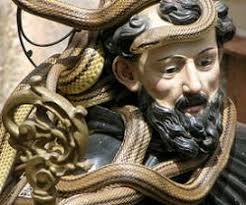 Mary and the Merry Month of May
Mary and the Merry Month of May
Spring’s beauty unfolds as wildflowers delight woodland walkers, new foliage glistens on trees, and another wave of blooms graces backyard shrubs. May is the month for patio parties, the dilemma of having to choose from six musical and fundraising events on the same weekend, and colorful festivals all over the world. What follows is a short list of these festivals that you just might consider adding to your bucket list:
In Cocullo, a tiny village in the Abruzzo province of Italy, the first Thursday in May is the Feast of Saint Domenic, for which snakes are collected from the environs during the previous six weeks. On the big day, the serpents are festooned over the head and shoulders of the larger-than-life statue of San Domenico, and the writhing assemblage is then paraded through the streets of the hamlet, promising believers immunity from snakebites for yet another year. In olden times, they then cooked and ate the snakes after the procession, but these days, they release the de-fanged reptiles to slither back into the forest.
Jerez de la Frontera in Andalucía, the Spanish capital of sherry, flamenco dancing, and horses, celebrates the annual Feria del Caballo (Horse Fair) in which a million people converge to indulge their love of all three for seven days of parades, horse competitions, flamenco, and the kind of revelry Spaniards are famous for.
In France, the glitterati make their May pilgrimage to the Cannes Film Festival. In Hong Kong, 60-foot towers are constructed and covered with thousands of sacred buns. Revelers, willing to make the challenging climb, grab and eat one for good luck during the Cheung Chau Bun Festival on Buddha’s birthday. In southern India, for the annual festival of Thrissur Pooram, a procession of elaborately decorated elephants and their riders treks along for 36 hours, accompanied by drumming and festive fireworks.
In Brockworth, England, a seven-pound wheel of cheese is set in motion down the steep grassy slope of Cooper’s Hill, and hundreds of people race or tumble down after it. The Lonely Planet travel guide says, “It’s like a spin-dry cycle to the bottom.” The first to grab the cheese gets to keep it, and all get to nurse their bruises and scrapes. Five cheeses are rolled at 20-minute intervals, in this now-international competition that grows in popularity every year despite the number of cheese fans who end up in the hospital. (But ambulances are parked at the bottom of the hill, always at the ready.)
Belgium holds an annual Dragon-Slaying Festival, with St. George on his black steed daring onlookers to get close enough to pull the dragon’s tail. It’s all great fun and games, as humanity celebrates the new flowering of life and the resurgence of hope and hormones.
The sense of rebirth and renewal comes from a deep, spiritual well. For Christians, the resurrection of Christ on Easter Sunday (between late March and late April) holds the promise of redemption, and in the Catholic tradition, the month of May is dedicated to Mother Mary. At St. Francis Elementary School, each of us kids in the fourth-grade class was to bring a tiny wreath of fresh flowers on our assigned day in May to place on the head of the statue of Mary, who prayed for us sinners from the back of the classroom. It was a big honor that kids, parents, and the nuns took quite seriously, and woe to the child who showed up empty-handed.
Some of the floral crowns were so large they slipped straight down to circle the statue’s feet, and Sister Mary Irene had to raid a couple of lunchboxes in the cloakroom for tinfoil to mold a headpiece inside the twined stems. Some were so small that they sailed off the ceramic brow at the first breeze, and found their escape through the window. I was sure we sang a special song each day to accompany the crowning, and also sure I didn’t remember it. Quite miraculously, it popped into my head as I was writing this, and an online check tells me that indeed it is the May crowning song: “Hail, Holy Queen enthroned above, ohhh Maa-rii-a . . . .”
In the Catholic Church, Mary holds dozens of titles: Blessed Mother, Queen of Heaven, Advocate of Sinners, and about 250 more, according to Wikipedia. My motive for exploring all this was to trace the source of traditional female names in Spanish: why would parents name their baby “Dolores” if it means “pains and sorrows,” or “Soledad,” signifying “solitude and loneliness”? These names and many others belong to Mary, as in “Our Lady of . . .” : Nuestra Señora de la Soledad, Nuestra Señora de Dolores, and more to come in the next paragraphs.
The Virgin Mary has many manifestations in history and the hearts of the faithful, and several of the more famous have long been popular female names: “Lourdes” (France, 1858), “Fátima” (Portugal, 1917), and “Guadalupe” (Mexico, 1531). Our Lady of Guadalupe is the patron saint of Mexico, and countless Mexican people carry her name. I didn’t realize that men too were named “Guadalupe” until, in a citywide teachers’ conference, the chairperson called upon “Lupe,” and my head whipped around when a deep male voice replied from the back of the room. In Spanish-speaking countries, men might be given “María” as a second name: José María, Jesús María, Alberto María, and so on. I remember being deeply puzzled as a child when I came across a book in my father’s collection authored by the Bohemian-born Austrian poet Rainier Maria Rilke. My mind was unable to grasp how he could possibly have a girl’s name.
“Dolores,” then, is María de Dolores—if not officially by baptism, then at least conceptually; “Soledad” is María de la Soledad, perhaps shortened to Marisol; “Mercedes” comes from Nuestra Señora de las Mercedes (Our Lady of Mercies); the beautiful name “Nieves” is from Our Lady of the Snows; and “Rocío” is from La Virgen del Rocío, the Virgin of the Morning Dew.
Mary is also the Patroness of Spain, invoked by the name of Nuestra Señora del Pilar, our Lady of the Pillar. On my first trip to Spain, the daughter of the family I stayed with was named “María del Pilar,” and everyone called her “Maripili,” or just “Pili” for short. The popular name “Carmen” comes from Nuestra Señora del Carmen (Our Lady of Mount Carmel), and the number of Spanish women named “María del Carmen,” or “Maricarmen” for short, is legion. Other titles for the Virgin Mary have given us the traditional Spanish names (with or without “María de”) Socorro (“help”), Refugio (“refuge”), Remedios (“remedies”), Imaculada (“immaculate”), Concepción (“immaculate conception”), Consuelo (“comfort”), Rosario (“rosary”), and Luz (“light”). A woman I knew in Sacramento named Amparo (“shelter”) was unfortunately nicknamed “Umpy” by her friends who couldn’t pronounce that beautiful word.
In her many guises as Our Lady of . . . (so many different manifestations), Mary is honored worldwide and year-round, but especially in the lovely month of May. My mother continues a lifelong devotion to her Mother Mary, having lost her own mom early in life. In the month of May and every day, love to her and all the mothers of the world.
